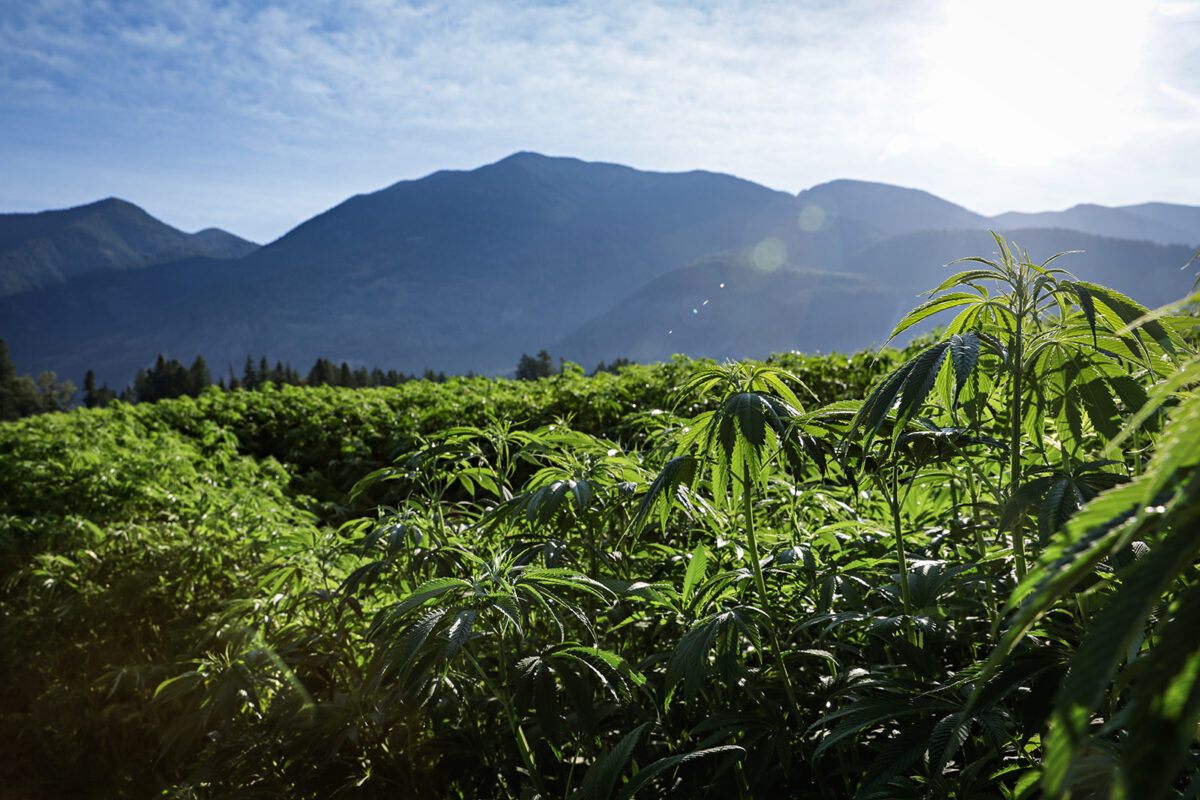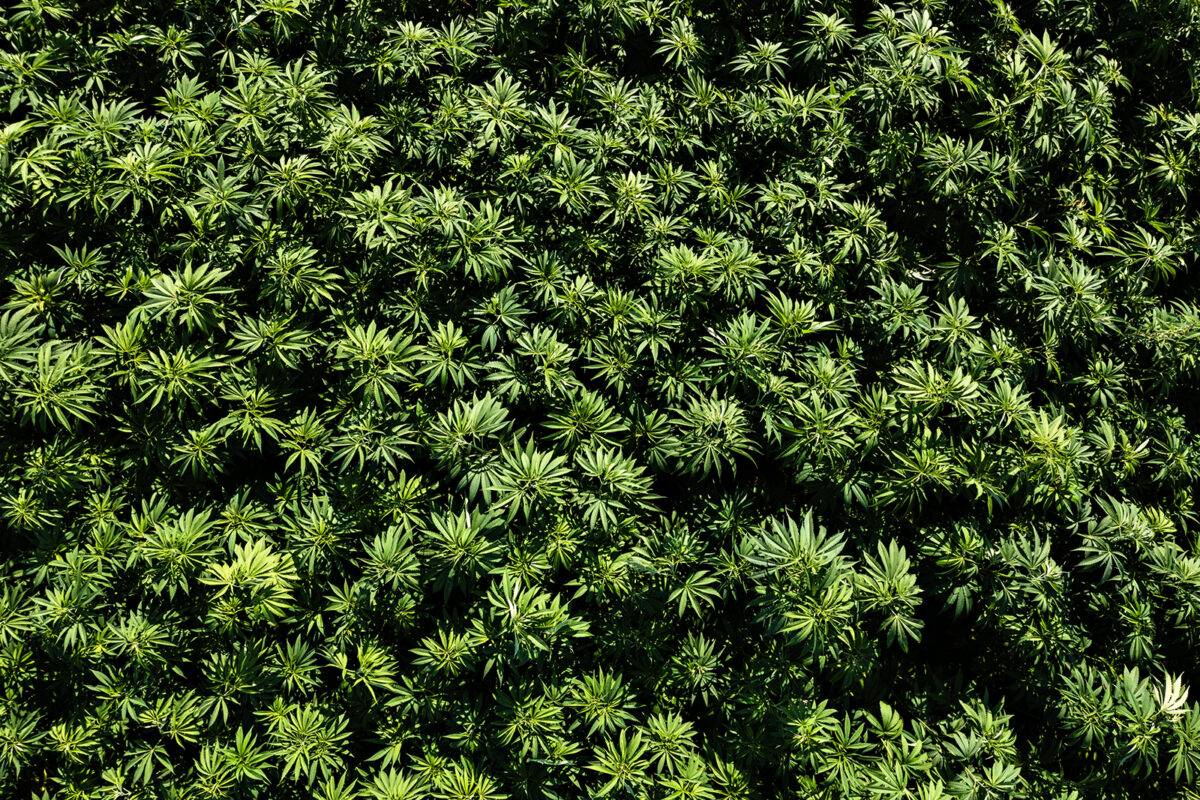
At a 165-acre plot north of Woody’s Country Store near Creston, local grower Tryg Koch has historically planted typical Flathead Valley commodity crops like alfalfa and yellow mustard on the property at the base of the Swan Mountain Range.
But Koch and his business partner, Lee Buller, of Heritage Custom Farm, threw a new crop in the plot’s rotation this year, planting industrial hemp that will be sent to a facility in Fort Benton this fall.
In their first year growing hemp in 2023, Koch said some of the irrigated plants grew to about 15 feet tall, yielding 3.8 tons per acre. Even in last year’s severe drought, most of the non-irrigated portion of the crop survived and the plants outcompeted most weeds due to their height.
“The biggest learning curve is in harvesting — growing it isn’t too bad,” Koch said. “We tend to fertilize this like a malt barley crop. It grows so tall and fast that weed management generally isn’t an issue.”
Harvest begins at the end of August when the fiber hemp is cut and the retting begins, a process where the fiber is left out to rot over the next several weeks.
“You want it rained on, you want it bleached out — you want it looking crappy,” Koch said.
After the retting process is complete, the fiber hemp is raked and baled by mid-September before it’s shipped to IND Hemp in Fort Benton, a hemp processing facility that has gained traction in recent years and is now sourcing hemp from across the state.


Koch first learned about IND Hemp from a Bozeman-based producer at the 2022 Grain Growers Convention in Great Falls. After visiting with the owners, he decided to add fiber hemp to his crop rotation last year. Following a successful harvest, he planted 165 acres in addition to 1,000 acres of hay, 550 acres of canola, 530 acres of winter wheat and 224 acres of red lentils for the 2024 season.
IND Hemp launched in Fort Benton six years ago when the 2018 Farm Bill legalized hemp production. Grouped in with all Cannabis sativa plants, the crop had previously been designated a Schedule I substance under the Controlled Substance Act, according to the U.S. Department of Agriculture.
While hemp and marijuana are both part of the cannabaceae family and contain delta-9 THC, which is the active ingredient that makes cannabis users feel “high,” the two species differ largely because of their delta-9 THC concentration. Hemp contains less than .3% delta-9 THC and is classified as a commodity crop before it’s converted into products like textiles, animal bedding and bioplastics. Cannabis concentrations beyond that threshold are classified as marijuana, which became recreationally legalized in Montana for its use and sale following the 2020 election.
Hemp was transported to North America in the 1600s and has traditionally been cultivated as a fiber source in temperate climates. The hempseed oil was historically used for products like paint, ink and lamp oil while the fiber was used for rope, wagon covers and clothing. But the introduction of cotton and tobacco led to a decline in hemp production in the 1800s.
Due to its link to marijuana, hemp was outlawed following the Marihuana Tax Act of 1937 when cannabis sativa became classified as a Schedule I drug under the Controlled Substance Act. Because there was no method to distinguish low-THC industrial hemp from high-THC varieties, all cannabis was outlawed.
Hemp cultivation remained illegal until the 2014 Farm Bill allowed pilot farms for agricultural research institutes to study the crop, beginning a path toward legalization that culminated in 2018.
“In 2014, it allowed hemp for research purposes and it’s important to note the state of Montana did the best job of any state to manage the research portion — there are really good state regulations and testing,” IND Hemp Brand and Marketing Director Gregg Gnecco said.
Hemp producers must obtain a license and undergo routine regulatory inspection and sampling through the Montana Department of Agriculture within three weeks before harvest to ensure THC levels are below the threshold.
Koch describes the state as easy to work with but says there are some extra steps compared to other commodity crops.
“We have to document everything, and we have to be fingerprinted. You kind of feel like a criminal growing it, and it’s very heavily regulated even though there are no seeds and it’s not used for CBD,” Koch said, referring to cannabidiol, a hemp-derived product.
By 2019, IND Hemp sourced the raw material from 3,000 acres around north-central Montana for hempseed oil production, which uses a cold press for equine supplements and pellets. The following year, they broke ground on the 52,000-square-foot fiber processing plant and now employees 40 people, making it one of the largest employers in Chouteau County.
The hemp stalk is composed of an outer bast fiber sleeve and an inner woody core, which are separated during a decortication process where 5 tons of raw stalk are processed per hour at the IND Hemp facility. Once they are separated, the outer sleeve of the stalk becomes the hemp bast fiber and the inner woody core is chipped to create hemp hurd. Each form is compatible with manufacturing processes like injection molding used for bioplastics.
Gnecco learned recently that after selling IND Hemp’s materials to a molding manufacturer, Montana’s fibers have since been used in bioplastics as part of Harley-Davidson motorcycle parts.
IND Hemp has also formed its own product brand called Hemptana as part of their operation, which includes hemp fiber nesting mats for hens, equine supplements like Hempseed Oil and Hempseed Hulls and ProBites, which can be purchased at Murdoch’s and North 40 Outfitters stores from Montana to Texas.
“I think the owners like to think of us as an environmental and sustainable company that expresses ourselves through hemp production,” Gnecco said.
Gnecco said the company has worked with roughly 30 families in recent years to source the hemp, and their reach is now growing in the Flathead Valley.


“For fiber specifically we really need to have good rain or irrigation, so that’s why we ended up in the Flathead Valley,” Gnecco said.
During the 2023 season, there were two growers in the Flathead Valley with roughly 260 acres and of hemp. After a successful season, there are now three growers and 685 acres of fiber hemp this year as farmers experiment with multiple varieties to see which is best suited for northwest Montana.
Nationwide, there are 22,248 acres of hemp fields planted while Montana, South Dakota and Idaho were among the country’s top fiber producers in 2023, according to a U.S. Department of Agriculture’s Farm Service Agency report.
According to IND Hemp agronomist Dalton Wittmer, the plant’s adaptability and potential for good profit margins and versatility on different soil types has attracted producers while there’s also a lower reliance on fertilizer.
Amy Gardner, an agronomist with Lower Valley Consulting, has been working with Wittmer to learn more about the crop and says it’s already contributed to positive soil health in the Flathead.
“When they’re harvesting the hemp for fiber, all of the leaves and nutrients are going back to our soil for our future crops and we’re building organic matter,” Gardner said.
Gardner says compared to other crops, hemp requires lower input costs and helps boost profit margins for producers.
“A big reason to start including hemp is its profitability,” Gardner said. “We know how to grow wheat in this valley, but given the high input costs and low crop prices, there are low profit margins and it’s getting harder and harder to pencil in a wheat crop. It’s nice to have some new crops to bring to the valley and helps growers stay profitable.”
In the last 18 years of growing commodity crops in the Flathead Valley, Koch has grown everything from winter wheat to omega-3 canola, but hay is the crop he prioritizes. The more crops that can be added to the rotation further boosts the soil health, yielding higher profit margins.
“Diversification and learning new markets is the key to staying successful and it’s kind of fun to try something different,” Koch said. “I’m not going to put the whole farm to hemp — just like I wouldn’t plant the whole farm to wheat. We feel that hemp just gives us one more crop in the valley for rotation.”
